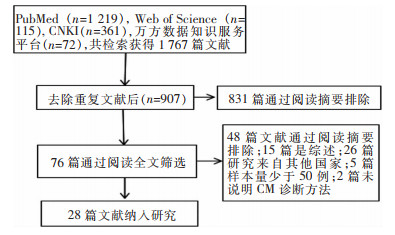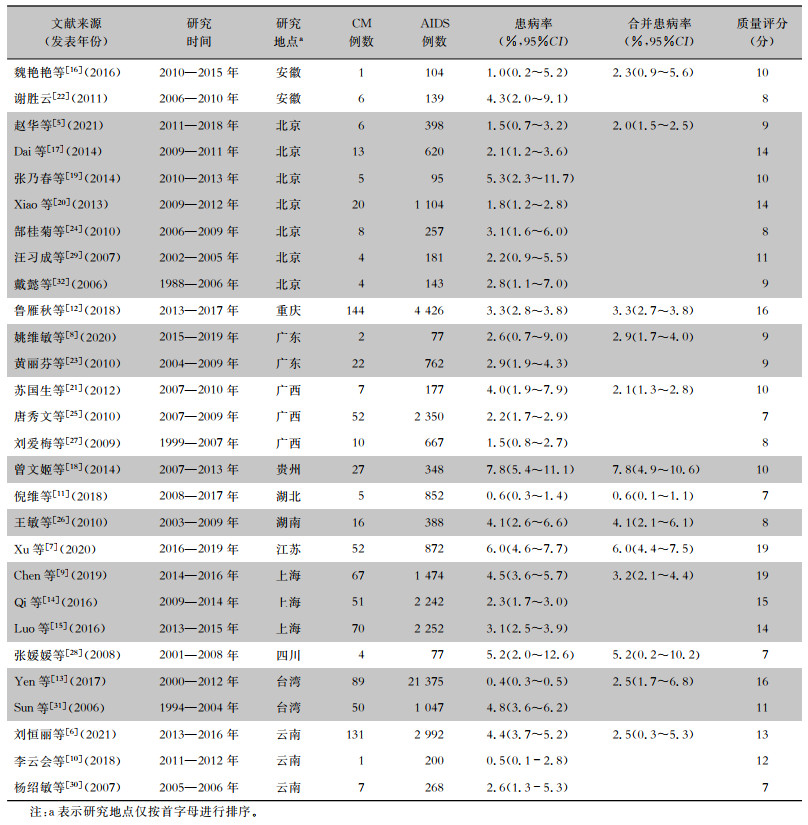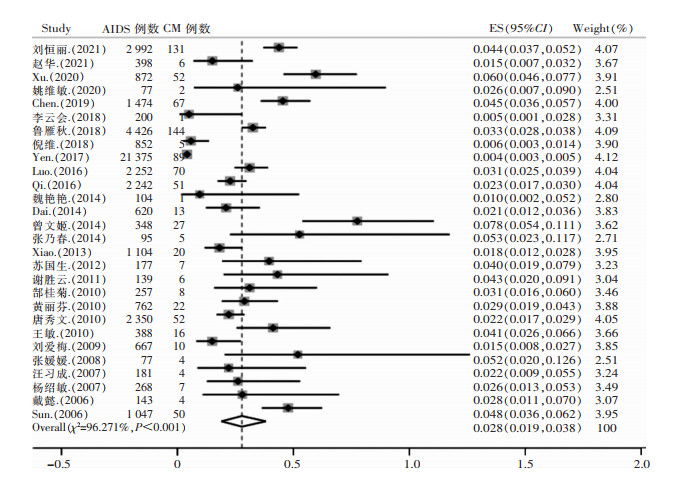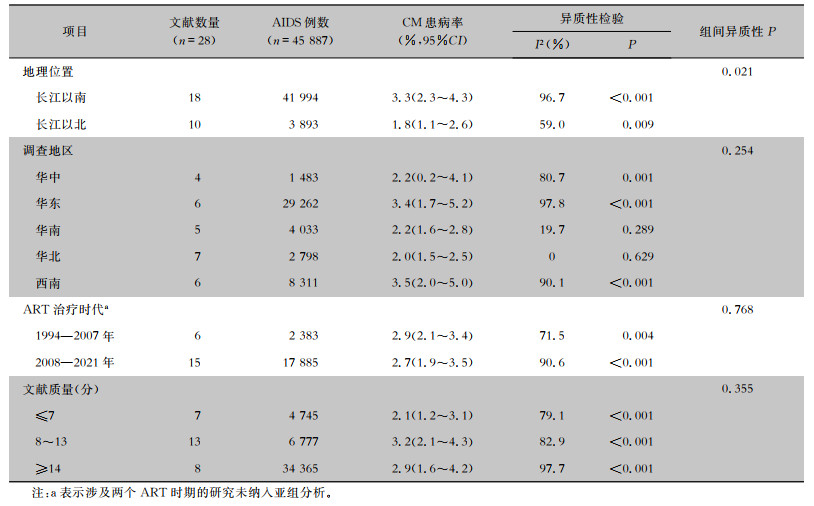2. 重庆市公共卫生医疗救治中心感染科,重庆 400036
2. Division of Infectious Diseases, Chongqing Public Health Medical Center, Chongqing 400036, China
隐球菌属是一种腐生性真菌,广泛存在于自然界。隐球菌性脑膜炎(cryptococcal meningitis, CM) 是中枢神经系统主要的真菌感染,也是导致艾滋病(acquired immunodeficiency syndrome, AIDS)患者住院和死亡的重要原因。全球每年约80%的CM病例都是由新生隐球菌感染引起,主要发生在艾滋病患者等免疫功能低下的人群[1]。全球每年有15.2万例AIDS合并隐球菌性脑膜炎(AIDS/CM)患者,其中73%的病例发生在撒哈拉以南的非洲[2]。随着抗逆转录治疗(antiretroviral therapy, ART)的广泛开展,全球范围内AIDS发病率和死亡人数持续下降,但AIDS/CM仍然是世界各国面临的严峻公共卫生问题,CM仍占AIDS相关死亡的15%[3]。中国作为AIDS疫情较为严重的国家之一,CM仍是AIDS患者常见的机会性感染和致死原因,然而,我国AIDS/CM的流行现状仍不清楚,不同地区研究结果差异较大[4]。鉴于此,本研究对现有的中国AIDS/CM患病率文献进行Meta分析,旨在了解我国AIDS/CM患病率及不同地区的疾病负担,为AIDS机会性感染防治提供科学依据。
1 资料与方法 1.1 检索策略使用医学主题词(MeSH)与自由词组合方式,在PubMed、Web of Science、中国知网(China National Knowledge Infrastructure, CNKI)和万方数据知识服务平台进行检索,获取中文、英文双语发表的AIDS/CM研究文献。检索词包括“meningitis, cryptococcal”“cryptococcal meningitis”“隐球菌性脑膜炎”“隐球菌病”,与“human immunodeficiency virus”“acquired immunodeficiency syndrome”“HIV”“AIDS”“人类免疫缺陷病毒”“获得性免疫缺陷综合征”,检索时间从数据库创建至2022年10月10日。本研究的方案已在国际平台INPLASY上进行注册(注册号为INPLASY202350041)。
1.2 纳入标准与排除标准通过阅读题目和摘要初步判断文献的相关性,对于相关性不明确的文献进一步阅读全文进行筛选。纳入标准:(1)研究对象为中国AIDS患者;(2)文献类型为观察性研究;(3)研究数据报告AIDS/CM患病率或具有足以用于计算AIDS/CM患病率的数据;(4)有明确的调查时间及研究方法;(5)CM诊断明确,即通过脑脊液墨汁染色镜检发现隐球菌,或血及脑脊液隐球菌培养阳性,或血及脑脊液隐球菌抗体检测阳性。排除标准:(1)综述或重复研究;(2)样本量<50例;(3)CM诊断方法未明确说明。
1.3 数据提取及质量评价采用预先设计的表格对符合条件的文献进行数据提取,包括:第一作者、发表年份、调查地区、总样本量、CM确诊患者数量、AIDS/CM患病率、诊断方法等。数据提取和质量评价由两名研究员独立完成,如有不同意见,通过与其他作者讨论达成共识。采用MOOSE声明对观察性研究进行Meta分析,包括背景、检索策略、方法、结果、讨论和结论6个部分。采用基于观察性研究的STROBE声明对纳入的文献进行质量评价,共22个条目评估横断面研究的质量:论文题目和摘要(条目1)、引言(条目2~3)、方法(条目4~12)、结果(条目13~17)、讨论(条目18~21)和其他信息(条目22)。
1.4 统计方法应用Stata 17.0软件对纳入的研究数据进行整合,计算获得合并患病率及95%置信区间(CI)。采用Cochran的Q检验和I2来评估研究之间的异质性,若研究存在异质性(I2>50%,P<0.1),采用随机效应模型进行分析;若研究不存在异质性(I2≤50%,P≥0.1),则采用固定效应模型进行分析。基于不同地理位置、调查地区、省份、AIDS患者ART时期、文献研究质量进行亚组分析,探讨异质性的来源。采用Egger’s检验分析文献发表偏倚。
2 结果 2.1 文献检索基本情况共检索获得1 767篇文献,除去860篇重复文献,通过阅读摘要排除831篇与AIDS/CM患病率无关的研究,其余76篇通过全文阅读进行筛选。最终纳入28篇[5-32]文献,文献筛选流程见图 1。研究覆盖13个省(市、自治区),共45 887例AIDS患者,其中合并CM患者874例。纳入文献质量评分为7~19分,≥14分的文献有8篇。见表 1。
 |
| 图 1 中国AIDS/CM患病率Meta分析的文献筛选流程图 Figure 1 Flowchart of literature screening for Meta-analysis on the prevalence of AIDS/CM in China |
| 表 1 中国AIDS/CM患病率Meta分析纳入文献的基本情况 Table 1 Baseline data of included literatures for Meta-analysis on the prevalence of AIDS/CM in China |

|
中国不同省份报道的AIDS/CM患病率为0.4%~7.8%, 合并相同省份(市、自治区)患病率,最高的是贵州省(7.8%,95%CI:4.9%~10.6%),最低的是湖北省(0.6%,95%CI:0.1%~1.1%),见表 1。因纳入的28篇文献存在异质性(I2=95.1%,P<0.001),遂采用随机效应模型合并患病率。结果显示,中国AIDS/CM总体患病率为2.8%(95%CI:1.9%~3.8%),见图 2。
 |
| 图 2 中国AIDS/CM总体患病率Meta分析森林图 Figure 2 Forest plot for Meta-analysis on the overall prevalence of AIDS/CM in China |
依据地理位置、调查地区、AIDS患者ART时期、文献质量进行亚组分析,结果显示长江以南的患病率为3.3%(95%CI:2.3%~4.3%),高于长江以北1.8%(95%CI:1.1%~2.6%),两者患病率比较,差异具有统计学意义(P=0.021)。西南地区AIDS/CM患病率高于华东、华南和华中,华北地区AIDS/CM患病率最低。有限ART时期(1994—2007年)AIDS/CM患病率为2.9%(95%CI:2.1%~3.4%),高于广泛ART时期(2008—2021年)的2.7%(95%CI:1.9%~3.5%),但不同ART时期AIDS/CM患病率比较,差异无统计学意义(P=0.768)。需要指出的是,在不同ART治疗时期亚组分析中,有7项研究因为研究期间包含两个时期而未纳入分析。不同研究质量的文献比较,AIDS/CM患病率差异无统计学意义(P=0.355),见表 2。
| 表 2 AIDS/CM患病率亚组分析结果 Table 2 Subgroup analysis on the prevalence of AIDS/CM |

|
采用Egger’s线性回归对发表偏倚的显著性进行评估,P<0.05提示存在发表偏倚。敏感性分析结果显示,在剔除任意一篇文献后,分析结果仍然稳定,AIDS/CM合并患病率为2.7%(95%CI:2.0%~3.4%)~3.0%(95%CI:2.2%~3.8%),各研究的样本量差异并未影响患病率结果。
3 讨论迄今,人类免疫缺陷病毒(HIV)感染人群中CM疾病负担并不清楚,总体上被严重低估[33]。本研究首次针对中国AIDS/CM疾病负担进行Meta分析,共纳入28篇文献,涉及45 887例AIDS患者,纳入的文献来自中国13个省份(市、自治区),具有样本量大和地域分布广的特点,因此,研究结果具有较好的代表性。随机效应模型显示,中国AIDS/CM总体患病率为2.8%,低于巴西(14%)及南非(5.35%)等[34-35]传统的AIDS高负担国家,但高于英国(0.36%)及西班牙(1.14%)等[36-37]发达国家。考虑到我国现有存活的HIV感染者人数已达114万[38]之多,该患病率数据表明我国AIDS/CM的疾病负担较重,应受到更多关注。
各省(市、自治区)AIDS/CM合并患病率为0.6%~7.8%,其中AIDS/CM患病率最高的贵州省为7.8%(95%CI:4.9%~10.6%),最低的是湖北省,为0.6%(95%CI:0.1%~1.1%)。就地区而言,AIDS/CM患病率由高到低为西南(3.5%)、华东(3.4%)、华中(2.2%)、华南(2.2%)和华北(2.0%);依据秦岭-淮河划分,中国南方AIDS/CM患病率高于北方,分别为3.3%、1.8%(P=0.021),总体呈现出南高北低。以上地域差异很可能与地理及自然条件不同有关,南方地区亚热带山地气候显著,适合真菌生长和传播,且中国AIDS患者较为集中的省份(市、自治区)也多在南方地区,包括云南、广东、广西、四川、贵州、重庆等。需要指出的是,本研究仅纳入通过脑脊液检查诊断的CM患者,而排除了通过血清学诊断或未说明诊断方法的研究,可能导致对CM患病率的低估。
尽管过去十余年间ART获得越来越广泛的推广,但本研究结果显示,CM疾病负担并未发生明显下降。甚至有研究[39]数据显示,自2011年以来,CM病例数量还有所增加。本研究依据不同ART时期进行的亚组分析发现,2008年及以后的广泛ART时期,AIDS/CM患病率(2.7%)较2008年以前的有限ART时期(2.9%)有所下降,但差异无统计学意义(P=0.768)。可能的原因包括:(1)晚发现、晚治疗仍是我国HIV感染者常见的问题,此类患者由于免疫功能严重受损,发生隐球菌感染的风险明显高于获得良好病毒学抑制的HIV感染者。近10年,我国35%以上的HIV感染者在获得诊断时CD4+T细胞计数<200个/μL,而CD4+T细胞计数<350个/μL者达60%~70%。(2)南方地区特别是西南地区中老年HIV感染者比例较髙,这类患者往往依从性较差,导致治疗失败和机会性感染的发生。
本研究属于无对照资料的Meta分析,采用Egger’s线性回归进行发表偏倚评估,结果显示存在发表偏倚(P<0.05)。为避免研究之间样本量的巨大差异所带来的异质性影响,本研究进行了敏感性分析,在剔除任意一篇文献后,AIDS/CM合并患病率均在2.7%~3.0%之间变化,结果稳定,表明各研究的样本量差异并未影响患病率结果。另外,有研究者[40]指出,患病率只是一个描述性结果,而不是差异比较结果,不存在所谓“阳性”结果或有统计学意义的结果,因此没必要做发表偏倚检测。
综上所述,本研究通过Meta分析发现,中国AIDS/CM负担较重,总体患病率为2.8%,不同地区患病率呈南高北低态势,由高到低为西南(3.5%)、华东(3.4%)、华中(2.2%)、华南(2.2%)和华北(2.0%),ART的广泛开展并未明显降低我国AIDS/CM的总体患病率。然而,由于受到原始数据的局限,本研究并未能提取CM患者的性别、年龄以及CD4+T细胞计数等数据,从而未能分析不同性别、年龄、CD4+T细胞计数之间AIDS/CM患病率是否有差异,此为本研究的不足之处。
利益冲突:所有作者均声明不存在利益冲突。
| [1] |
"十三五"国家科技重大专项艾滋病机会性感染课题组. 艾滋病合并隐球菌病临床诊疗的专家共识[J]. 西南大学学报(自然科学版), 2020, 42(7): 1-19. AIDS-Associated Opportunistic Infections Research Group of the National Science and Technology Major Project of China During the 13th Five-Year Plan Period. Expert consensus on the diagnosis and treatment of cryptococcosis in AIDS patients[J]. Journal of Southwest University(Natural Science Edition), 2020, 42(7): 1-19. |
| [2] |
Rajasingham R, Govender NP, Jordan A, et al. The global burden of HIV-associated cryptococcal infection in adults in 2020:a modelling analysis[J]. Lancet Infect Dis, 2022, 22(12): 1748-1755. DOI:10.1016/S1473-3099(22)00499-6 |
| [3] |
Rajasingham R, Smith RM, Park BJ, et al. Global burden of disease of HIV-associated cryptococcal meningitis: an updated analysis[J]. Lancet Infect Dis, 2017, 17(8): 873-881. DOI:10.1016/S1473-3099(17)30243-8 |
| [4] |
Fang W, Fa ZZ, Liao WQ. Epidemiology of Cryptococcus and cryptococcosis in China[J]. Fungal Genet Biol, 2015, 78: 7-15. DOI:10.1016/j.fgb.2014.10.017 |
| [5] |
赵华, 张利, 李洪云, 等. 艾滋病患者合并机会性感染的临床特点及预后分析[J]. 解放军医学院学报, 2021, 42(1): 45-47, 52. Zhao H, Zhang L, Li HY, et al. Opportunistic infection in AIDS patients: clinical features, prognosis and its risk factors[J]. Academic Journal of Chinese PLA Medical School, 2021, 42(1): 45-47, 52. DOI:10.3969/j.issn.2095-5227.2021.01.010 |
| [6] |
刘恒丽, 李侠, 杨欣平, 等. 云南省2 992例HIV/AIDS住院患者临床特征分析[J]. 中国皮肤性病学杂志, 2021, 35(5): 525-530. Liu HL, Li X, Yang XP, et al. Analysis of clinical features of 2 992 inpatients with HIV/AIDS in Yunnan province[J]. The Chinese Journal of Dermatovenereology, 2021, 35(5): 525-530. |
| [7] |
Xu MM, Peng ZH, Xu CJ, et al. Underlying cryptococcal di-seases and the correlation with serum cryptococcal antigen titers in hospitalized HIV-infected patients screened positive for cryptococcal antigenemia[J]. Front Cell Infect Microbiol, 2020, 10: 170. DOI:10.3389/fcimb.2020.00170 |
| [8] |
姚维敏, 李智勇, 郭健文, 等. 南海区77例艾滋病患者相关机会性感染临床研究[J]. 深圳中西医结合杂志, 2020, 30(13): 119-120. Yao WM, Li ZY, Guo JW, et al. Clinical study of 77 AIDS-related opportunistic infections in Nanhai District[J]. Shen-zhen Journal of Integrated Traditional Chinese and Western Medicine, 2020, 30(13): 119-120. |
| [9] |
Chen J, Zhang R, Shen Y, et al. Serum cryptococcal antigen titre as a diagnostic tool and a predictor of mortality in HIV-infected patients with cryptococcal meningitis[J]. HIV Med, 2019, 20(1): 69-73. DOI:10.1111/hiv.12679 |
| [10] |
李云会, 黎奇, 白劲松, 等. HIV/AIDS患者深部真菌感染状况及药敏研究[J]. 皮肤病与性病, 2018, 40(2): 168-171. Li YH, Li Q, Bai JS, et al. Drug sensitivity study and risk factor analysis of deep fungal infection among HIV/AIDS patients[J]. Journal of Dermatology and Venereology, 2018, 40(2): 168-171. |
| [11] |
倪维, 杨柳, 刘光忠. 中医院艾滋病患者感染深部真菌分布及耐药性[J]. 中国医药导报, 2018, 15(19): 139-142. Ni W, Yang L, Liu GZ. Distribution and drug resistance of deep fungus from AIDS patients with infection in hospital of traditional Chinese medicine[J]. China Medical Herald, 2018, 15(19): 139-142. |
| [12] |
鲁雁秋, 黄晓婕, 刘敏, 等. 重庆地区499例艾滋病合并中枢神经系统感染患者的疾病谱及预后影响因素分析[J]. 中华传染病杂志, 2018, 36(2): 65-68. Lu YQ, Huang XJ, Liu M, et al. Disease spectrum and prognostic factors of 499 cases of acquired immune deficiency syndrome complicated with central nervous system infections in Chongqing[J]. Chinese Journal of Infectious Diseases, 2018, 36(2): 65-68. |
| [13] |
Yen YF, Chen M, Jen I, et al. Association of HIV and opportunistic infections with incident stroke: a nationwide population-based cohort study in Taiwan[J]. J Acquir Immune Defic Syndr, 2017, 74(2): 117-125. DOI:10.1097/QAI.0000000000001216 |
| [14] |
Qi T, Zhang R, Shen Y, et al. Etiology and clinical features of 229 cases of bloodstream infection among Chinese HIV/AIDS patients: a retrospective cross-sectional study[J]. Eur J Clin Microbiol Infect Dis, 2016, 35(11): 1767-1770. DOI:10.1007/s10096-016-2724-7 |
| [15] |
Luo B, Sun JJ, Cai RT, et al. Spectrum of opportunistic infections and risk factors for in-hospital mortality of admitted AIDS patients in shanghai[J]. Medicine (Baltimore), 2016, 95(21): e3802. DOI:10.1097/MD.0000000000003802 |
| [16] |
魏艳艳, 邹桂舟, 叶珺, 等. 艾滋病合并机会性感染104例临床分析[J]. 安徽医药, 2016, 20(4): 679-682. Wei YY, Zou GZ, Ye J, et al. The clinical analysis of opportunistic infections in 104 patients with acquired immunodeficiency syndrome(AIDS)[J]. Anhui Medical and Pharmaceutical Journal, 2016, 20(4): 679-682. |
| [17] |
Dai LL, Mahajan SD, Guo CP, et al. Spectrum of central ner-vous system disorders in hospitalized HIV/AIDS patients (2009-2011) at a major HIV/AIDS referral center in Beijing, China[J]. J Neurol Sci, 2014, 342(1-2): 88-92. DOI:10.1016/j.jns.2014.04.031 |
| [18] |
曾文姬, 刘水青, 李鹏. 348例HIV/AIDS病人血清隐球菌抗原筛查的结果分析[J]. 中国艾滋病性病, 2014, 20(7): 486-488. Zeng WJ, Liu SQ, Li P. Result analysis of serum cryptococcal antigen screening among 348 HIV/AIDS patients[J]. Chinese Journal of AIDS & STD, 2014, 20(7): 486-488. |
| [19] |
张乃春, 张昕, 赵敏. 95例HIV/AIDS合并机会性感染病例的临床特征[J]. 中国艾滋病性病, 2014, 20(11): 804-808. Zhang NC, Zhang X, Zhao M. Clinical characteristics of opportunistic infections in 95 HIV/AIDS patients[J]. Chinese Journal of AIDS & STD, 2014, 20(11): 804-808. |
| [20] |
Xiao J, Gao GJ, Li YM, et al. Spectrums of opportunistic infections and malignancies in HIV-infected patients in tertiary care hospital, China[J]. PLoS One, 2013, 8(10): e75915. |
| [21] |
苏国生, 韦善求, 罗晓璐, 等. 南宁市HIV/AIDS患者机会性感染177例的临床分析[J]. 广西医学, 2012, 34(8): 1000-1001. Su GS, Wei SQ, Luo XL, et al. Clinical analysis of 177 cases of opportunistic infection in HIV/AIDS patients in Nanning[J]. Guangxi Medical Journal, 2012, 34(8): 1000-1001. |
| [22] |
谢胜云. 139例艾滋病患者机会性感染情况分析[J]. 齐齐哈尔医学院学报, 2011, 32(13): 2080-2081. Xie SY. Analysis of opportunistic infection in 139 AIDS patients[J]. Journal of Qiqihar University of Medicine, 2011, 32(13): 2080-2081. |
| [23] |
黄丽芬, 唐小平, 蔡卫平, 等. 广东地区762例住院人类免疫缺陷病毒感染患者机会性感染分析[J]. 中华内科杂志, 2010, 49(8): 653-656. Huang LF, Tang XP, Cai WP, et al. An analysis of opportunistic infection in 762 inpatients with human immunodeficiency virus infection in Guangdong areas[J]. Chinese Journal of Internal Medicine, 2010, 49(8): 653-656. |
| [24] |
郜桂菊, 毛羽, 赵红心, 等. 257例艾滋病病人机会性感染情况分析[J]. 中国艾滋病性病, 2010, 16(2): 134-137. Gao GJ, Mao Y, Zhao HX, et al. Analysis of the overall charcteristics of opportunistic infection among 257 AIDS patients[J]. Chinese Journal of AIDS & STD, 2010, 16(2): 134-137. |
| [25] |
唐秀文, 张晶. 2 350例艾滋病患者血液培养病原体和药敏结果分析[J]. 广西医学, 2010, 32(7): 782-785. Tang XW, Zhang J. Analysis of the blood-cultivated pathogen and drug-sensitivity from 2 350 cases of AIDS patients[J]. Guangxi Medical Journal, 2010, 32(7): 782-785. |
| [26] |
王敏, 范学工, 徐丹, 等. 388例HIV/AIDS患者临床特点与机会性感染发病谱[J]. 实用预防医学, 2010, 17(1): 168-171. Wang M, Fan XG, Xu D, et al. Spectrum of opportunistic infections and clinical characteristic of 388 patients with HIV/AIDS[J]. Practical Preventive Medicine, 2010, 17(1): 168-171. |
| [27] |
刘爱梅, 许建荣, 陈敬捷, 等. 广西地区艾滋病相关性机会感染的疾病谱分析[J]. 中华传染病杂志, 2009, 27(3): 178-182. Liu AM, Xu JR, Chen JJ, et al. Disease spectrum analysis of AIDS -related opportunistic infections in Guangxi[J]. Chinese Journal of Infectious Diseases, 2009, 27(3): 178-182. |
| [28] |
张媛媛, 陈恩强, 李红, 等. 人类免疫缺陷病毒感染77例临床特点分析[J]. 临床荟萃, 2008, 23(23): 1722-1724. Zhang YY, Chen EQ, Li H, et al. Clinical analysis of 77 cases of human immunodeficiency virus infection[J]. Clinical Focus, 2008, 23(23): 1722-1724. |
| [29] |
汪习成, 黄晓婕, 张彤, 等. HIV/AIDS患者机会性感染特点分析[J]. 中华内科杂志, 2007, 46(5): 379-382. Wang XC, Huang XJ, Zhang T, et al. The characteristics of opportunistic infections in 181 HIV/AIDS patients in China[J]. Chinese Journal of Internal Medicine, 2007, 46(5): 379-382. |
| [30] |
杨绍敏, 张米, 李正伦, 等. 268例艾滋病合并机会性感染患者血液、体液培养结果分析[J]. 中国真菌学杂志, 2007, 2(4): 217-219. Yang SM, Zhang M, Li ZL, et al. Analysis on the results of blood and body fluid cultures in 268 AIDS patients of opportunistic infection[J]. Chinese Journal of Mycology, 2007, 2(4): 217-219. |
| [31] |
Sun HY, Chen MY, Hsiao CF, et al. Endemic fungal infections caused by Cryptococcus neoformans and Penicillium marneffei in patients infected with human immunodeficiency virus and treated with highly active anti-retroviral therapy[J]. Clin Microbiol Infect, 2006, 12(4): 381-388. |
| [32] |
戴懿, 李太生, 王爱霞, 等. 143例首诊发现的中国艾滋病患者临床特征分析[J]. 中国医学科学院学报, 2006, 28(5): 651-654. Dai Y, Li TS, Wang AX, et al. Clinical characteristics of 143 Chinese HIV/AIDS patients[J]. Acta Academiae Medicinae Sinicae, 2006, 28(5): 651-654. |
| [33] |
Chen M, Xu N, Xu JP. Cryptococcus neoformans meningitis cases among China's HIV-infected population may have been severely under-reported[J]. Mycopathologia, 2020, 185(6): 971-974. |
| [34] |
Telles JP, Fernandes R, Barros TD, et al. Neurological manifestations in people living with HIV/AIDS in the late cART era: a prospective observational study at a tertiary healthcare center in São Paulo, Brazil[J]. HIV Res Clin Pract, 2021, 22(4): 87-95. |
| [35] |
Deiss R, Loreti CV, Gutierrez AG, et al. High burden of cryptococcal antigenemia and meningitis among patients pre-senting at an emergency department in Maputo, Mozambique[J]. PLoS One, 2021, 16(4): e0250195. |
| [36] |
Edwards RJ, Boyce G, Alastruey-Izquierdo A, et al. Updated estimated incidence and prevalence of serious fungal infections in Trinidad and Tobago[J]. IJID Reg, 2021, 1: 34-40. |
| [37] |
Cabello úbeda A, Fortes Alen J, Gadea I, et al. Cryptococcal meningoencephalitis. Epidemiology and mortality risk factors in pre-and post-HAART era[J]. Med Clin (Barc), 2016, 146(9): 397-401. |
| [38] |
张宇慧. 低流行水平!我国报告现存艾滋病感染者114万例[EB/OL]. (2021-12-01)[2023-02-20]. http://news.cyol.com/gb/articles/2021-12/01/content_4yvEBsWlw.html. Zhang YH. Low popularity level! China has reported 1.14 million cases of HIV infection[EB/OL]. (2021-12-01)[2023-02-20]. http://news.cyol.com/gb/articles/2021-12/01/content_4yvEBsWlw.html. |
| [39] |
Tenforde MW, Mokomane M, Leeme T, et al. Advanced human immunodeficiency virus disease in Botswana following successful antiretroviral therapy rollout: incidence of and temporal trends in cryptococcal meningitis[J]. Clin Infect Dis, 2017, 65(5): 779-786. |
| [40] |
Borenstein M. Common mistakes in Meta-analysis and how to avoid them[M]. New Jersey, USA: Biostat, Inc, 2019.
|



